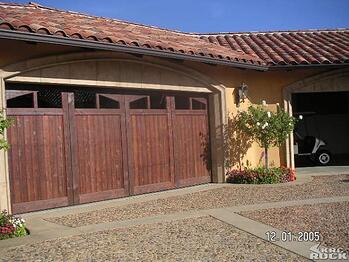EXPOSED AGGREGATE CONCRETE

Exposed aggregate is a term that describes one way to dress or finish poured-in-place concrete. They literally will pour the concrete from a mixer truck, trowel it and then let it set up just a little bit. They then take an acid and wash off the top cream of the cement, exposing the rock and minerals they’ve added to the mix (the aggregate).
Pavers on the other hand are manufactured in a controlled environment plant where the concrete is pressed and compacted into a mold. The pieces are then kiln dried for a complete cure and shipped to a job site on pallets. Each piece is individually installed (usually on a sand setting bed). There is a huge variety of shape, color, texture and pattern that these pieces can look like.
When considering concrete products in Connecticut, we must account for the weather and most specifically the freeze/thaw patterns that we get here. Our climate is not kind to concrete – at all. It cracks. Every time the ground freezes it expands. As it thaws, it settles back down. This process repeats itself sometimes as often as every day/night in the spring and fall in our area of the country. In order to slow down the inevitable cracking, the concrete pour has to be very thick and reinforced with steel mesh and rebar. It also requires a well compacted and prepared base…. All this to say, exposed aggregate concrete may not be the best solution in Connecticut. It is a beautiful pavement choice for much warmer climates that don't experience a lot of frost.
INTERLOCKING CONCRETE PAVERS
Pavers are meant to be a flexible pavement solution that flexes with the freeze/thaw cycles. Because there are individual pieces there are no unwanted cracks. The joints between the pavers take the stress of the weather and disperse it without cracking the pieces. Like the concrete, the base is critical to a good paver installation. It needs to be very well compacted and at the proper depth (determined by the soil type and whether it needs to be strong enough for vehicular traffic or not).

For more information, consider reading our other blog articles:
A Side-by-side Comparison of Stamped Concrete and Pavers
How much does a Paver Patio Cost?
How to Install Pavers in Connecticut
Quality Workmanship for a Paver Installation. Is it worth the price?